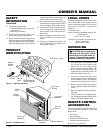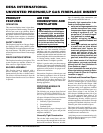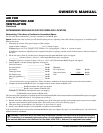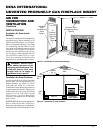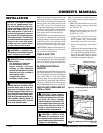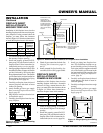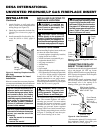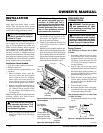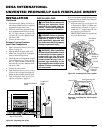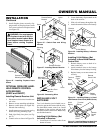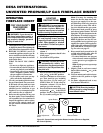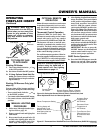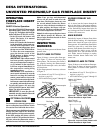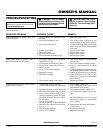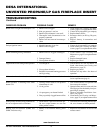Special offers from our partners!

Find Replacement BBQ Parts for 20,308 Models. Repair your BBQ today.

11
105648
OWNER’S MANUAL
For more information, visit www.desatech.com
Figure 19- Removing Log Base Assembly
From Fireplace
CAUTION: Do not pick up log
base assembly by burners. This
could damage burners. Only
handle base by grates.
INSTALLATION
Continued
NOTICE: Most building codes do
not permit concealed gas con-
nections. A flexible gas line is
provided to allow connection with
the fireplace (see Figure 20). The
flexible gas supply line connec-
tion to the equipment shutoff
valve should be accessible.
3. Route gas supply line through access
opening of fireplace insert (see Figure
2, page 3).
Installation Items Needed
• 5/16" hex socket wrench or nut-driver
• Phillips screwdriver
• sealant (resistant to propane/LP gas, not
provided)
1. Remove fireplace insert screen. Re-
move two screws that hold fireplace
insert screen in place for shipping.
These screws are located near top of
screen. Discard screws. Lift fireplace
insert screen up and pull out to remove.
2. Remove screws that attach log base as-
sembly to fireplace insert (see Figure
19). Carefully lift up log base assem-
bly and remove from fireplace insert
(see Figure 19).
Note:
If adding the G8010 series brick liner
accessory, install it now. Follow instruc-
tions in G8010 accessory kit.
CAUTION: Use pipe joint seal-
ant that is resistant to liquid pe-
troleum (LP) gas.
We recommend that you install a sediment
trap in supply line as shown in Figure 18,
page 10. Locate sediment trap where it is
within reach for cleaning. Install in piping
system between fuel supply and heater. Lo-
cate sediment trap where trapped matter is
not likely to freeze. A sediment trap traps
moisture and contaminants. This keeps them
from going into fireplace insert gas controls.
If sediment trap is not installed or is installed
wrong, fireplace may not run properly.
4. Connect gas supply line to flexible gas
line attached to gas regulator of fire-
place insert (see Figure20). Use seal-
ant on all male pipe threads.
5. Check all gas connections for leaks. See
Checking Gas Connections, column 3
and page 12.
6. Replace log base assembly back into fire-
place insert. Feed flexible gas line into fire-
place insert base area while replacing log
base assembly. Make sure the entire flex-
ible gas line is in fireplace insert base area.
Reattach log base assembly to fireplace
insert with screws removed in step 2.
Figure 20 - Attaching Gas Lines
Flexible Gas Line
from Fireplace Gas
Regulator Provided
with Fireplace Insert
To Fireplace
Gas Regulator
Equipment
Shutoff
Valve
➞
➞
To External
Regulator
Continued
Pressure Testing Gas Supply
Piping System
Test Pressures In Excess Of 1/2 PSIG
(3.5 kPa)
1. Disconnect appliance from its appli-
ance main gas valve (control valve) and
equipment shutoff valve from gas sup-
ply piping system. Pressures in excess
of 1/2 psig will damage fireplace in-
sert gas regulator.
2. Cap off open end of gas pipe where
equipment shutoff valve was connected.
3. Pressurize supply piping system by ei-
ther using compressed air or opening
propane/LP supply tank valve.
4. Check all joints of gas supply piping
system. Apply mixture of liquid soap
and water to gas joints. Bubbles form-
ing show a leak.
5. Correct all leaks at once.
6. Reconnect fireplace insert and equip-
ment shutoff valve to gas supply. Check
reconnected fittings for leaks.
Test Pressures Equal To or Less Than
1/2 PSIG (3.5 kPa)
1. Close equipment shutoff valve (see Fig-
ure 21).
CHECKING GAS
CONNECTIONS
WARNING: Test all gas pip-
ing and connections for leaks
after installing or servicing. Cor-
rect all leaks at once.
WARNING: Never use an open
flame to check for a leak. Apply a
mixture of liquid soap and water
to all joints. Bubbles forming show
a leak. Correct all leaks at once.
Figure 21 - Equipment Shutoff Valve
ON
POSITION
OFF
POSITION
Open
Closed
Equipment
Shutoff
Valve
O
F
F
P
I
L
O
T
O
N
H
I
L
O
Burners
Two
Screws
Log Base
Assembly
Apply pipe joint sealant lightly to male
threads. This will prevent excess sealant
from going into pipe. Excess sealant in pipe
could result in clogged fireplace valves.



